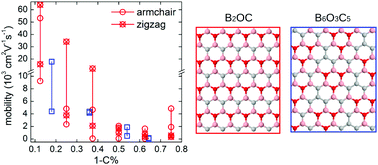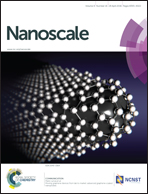Two-dimensional B–C–O alloys: a promising class of 2D materials for electronic devices†
Abstract
Graphene, a superior 2D material with high carrier mobility, has limited application in electronic devices due to zero band gap. In this regard, boron and nitrogen atoms have been integrated into the graphene lattice to fabricate 2D semiconducting heterostructures. It is an intriguing question whether oxygen can, as a replacement of nitrogen, enter the sp2 honeycomb lattice and form stable B–C–O monolayer structures. Here we explore the atomic structures, energetic and thermodynamic stability, and electronic properties of various 2D B–C–O alloys using first-principles calculations. Our results show that oxygen can be stably incorporated into the graphene lattice by bonding with boron. The B and O species favor forming alternate patterns into the chain- or ring-like structures embedded in the pristine graphene regions. These B–C–O hybrid sheets can be either metals or semiconductors depending on the B : O ratio. The semiconducting (B2O)nCm and (B6O3)nCm phases exist under the B- and O-rich conditions, and possess a tunable band gap of 1.0–3.8 eV and high carrier mobility, retaining ∼1000 cm2 V−1 s−1 even for half coverage of B and O atoms. These B–C–O alloys form a new class of 2D materials that are promising candidates for high-speed electronic devices.

- This article is part of the themed collection: 2016 Nanoscale HOT Article Collection

 Please wait while we load your content...
Please wait while we load your content...